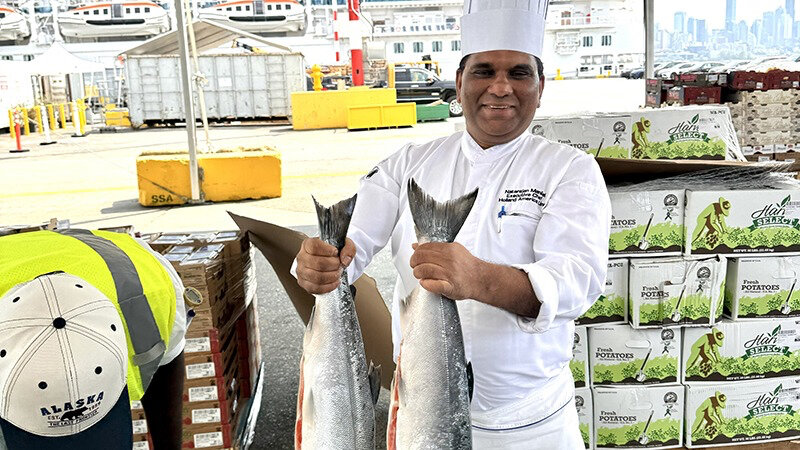
I’m standing on a dock in Seattle on a Saturday morning in August, just a few feet away from the towering form of the Holland America Eurodam.
Eurodam head chef Natarajan Manilal and I are surrounded by dozens of pallets of fresh fish and produce that are about to be tucked into the belly of the Eurodam for a seven-day Alaska cruise. The loading procedure is an intricate, tightly choreographed dance that happens prior to every cruise, but one that most cruise pax never see.
We’re only a couple hours from departure, but Manilal is giving me an up-close and personal explanation of Holland America’s Global Fresh Fish program and examining the goods. He peels back the cardboard on one of the dozens of containers of fish and scoops out two lovely salmon.
“We’ll be getting fresh salmon, halibut and mussels today and black cod in Seattle. It’s really good fish. We’ll get more in Juneau and more again in Ketchikan.”
Holland America last year introduced a first-of-its kind Global Fresh Fish Program, which provides cruise pax with more than 80 varieties of fresh fish sourced from around the world. All the fish is brought from port to plate within 48 hours.
Holland America was the first cruise line to be certified by the Responsible Fisheries Management (RFM) for sustainable Alaska seafood. RFM certified all six ships that sail to Alaska after an independent audit.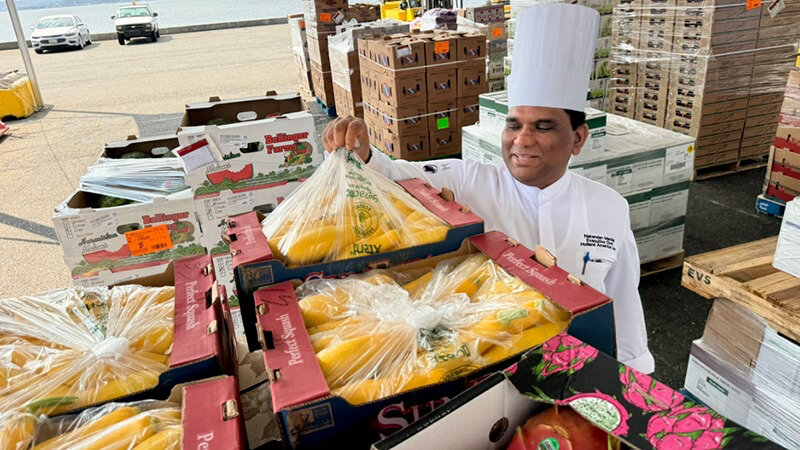
“We have to produce a lot of documents to show we follow RFM procedures, 100%” John Mulvaney, Director of Culinary Operations at Holland America Line, told Open Jaw in an interview. “They have two inspectors come on board the ship. They check our invoices, they check our meal counts. We have to keep records for three years.
Holland America Line also was the first global cruise line to receive both Marine Stewardship Council (MSC) and Aquaculture Stewardship Council (ASC) certifications. HAL officials say the two organizations serve as the most credible standards worldwide for certified seafood.
The Marine Stewardship Council’s focus is on sustainable wild-caught seafood, while Aquaculture Stewardship Council works with responsibly farmed seafood. Both organizations seeking to minimize environmental impacts.
“Up to 80% of fish served on Alaska cruises is fresh,” Mulvaney said. “If a fishing boat can’t deliver fresh fish, and sometimes weather or other obstacles arise, Holland America will use fish that’s flash frozen at sea. But we don’t serve that has been sitting around for months.”
Mulvaney said last year was HAL’s first year with the program in Alaska.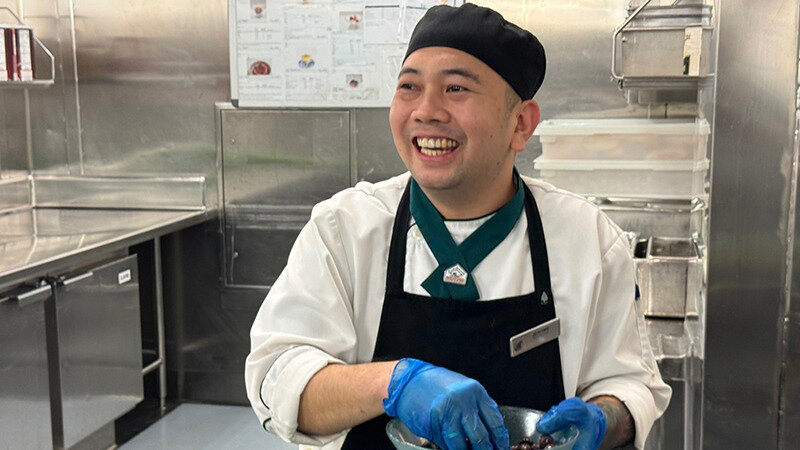
“This year we’ve expanded to North America and Europe. For winter we’ll expand to the Caribbean, South America, Asia, Australia, and Hawaii.”
Holland America’s website lists yellowtail snapper and mahi mahi as two fresh fish a guest might dine on in the Caribbean. European options include tuna, rainbow trout and Dover sole.
“We are really focusing on regionally inspired cuisine and that includes our fish,” Bill Zucker, HAL’s Vice President, Public Relations and Communications, told me on board the Eurodam. “Here in Alaska, that means we are serving fresh Alaska certified sustainable fish.
“Two years ago we were audited by RFM, which audits for the traceability and sustainability of fish, and all of our Alaska ships passed that audit. We know that local, Alaska fishing families are ultimately providing us with fresh, sustainable fish, which then becomes the wonderful cuisine you see” on the ship, Zucker said.
Back on the dock in Seattle, Manilal leans into a box of fresh Pacific cod. He picks up a filet and pushes it gently with his thumb.
“If you can push your thumb down too far that means it’s not fresh,” he says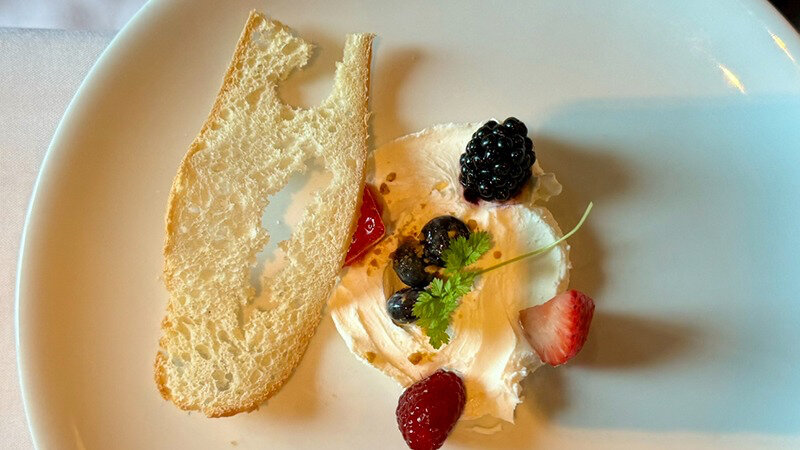
Choosing the right fish is important. But so is the handling. Manilal says Holland America keeps it fresh fish away from any frozen fish that’s required. It’s stored separately and cooked separately, as well.
Manilal tells me the ship is loading 1,800 kilos of salmon for the cruise, which is astonishing. He’ll go through roughly a ton of flour for a one-week trip, and six thousand eggs per day. Then again, there are 2,200 guests on board for 14 lunches and dinners, plus a crew of 900 more.
Of course, fresh fruit and veggies also critical to the cruise, especially when visiting a place like Alaska, which isn’t known for its fresh produce.
I spot massive pallets full of pink and green dragon fruit, blueberries, brilliant yellow squash and bright red strawberries.
“We have most all fresh fruits and veggies on board,” Manilal tells me. “We can come to Seattle and get fresh Washington cherries and other produce. It really is port to table. We put a strong emphasis on fresh, local food.”
Selections on the ship during our cruise included fresh salmon with mango sauce, fresh halibut with prosciutto and fresh cod with endive and caramelized orange.
Two of the specialty restaurants (extra charge), Canaletto for Italian and Tamarind for Asian, also served up tremendous fish dishes. At Canaletto I dove into tremendous pasta with calamari, mussels and plump, perfect scallops. At Tamarind I also loved the Thai Citrus Scallops.
Of course, cruisers do not survive on fish alone, so we also sampled melt-in-your mouth beef tenderloin, lobster dumplings and rich, umami-laden forest mushroom soup with truffles at Pinnacle Grill, another specialty dining spot on the Eurodam.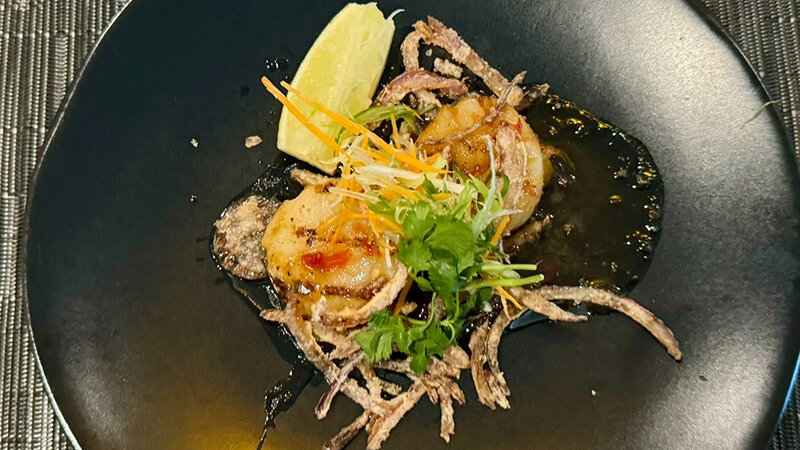
At the Alaskan buffet breakfast, I enjoyed excellent scrambled eggs and reindeer sausage, which tasted like a slightly spicy kielbasa to me. I also quite liked the salmon and crab cakes.
A good friend of mine from Wisconsin, also named Jim, was on the cruise with me. Just for fun, we went to the Eurodam’s casual “Dive-In” poolside bar one day for a bratwurst lunch. A dedicated brat lover, and an excellent cook, Jim gave me the thumbs up after biting into his.
The ship’s super-friendly sommelier also guided on us on fun, informative wine tastings that contrasted wonderful Washington State wines with European varieties.
One day at sea Manilal gave a cooking demonstration, including tips on how to cook salmon. He suggests using a saute pan on high heat. And he said you can tell it’s cooked when little white bits emerge from the fish.
In an interview in the massive ship’s kitchen on one of the lower decks, Manilal told me he enjoys visiting different parts of the world so he can choose from different local foods.
“In the Caribbean we can get mahi mahi or tuna or fresh, tropical fruits. It’s good fun.”
Planning meals for more than 3,000 people for a full week at sea is a challenging experience, but Manilal, who’s been with Holland America for 15 years, shows off a series of large charts on a wall of the kitchen that outline everything from a huge variety of meal options, including teriyaki salmon, eggplant parmigiano and stroopwaffel cheesecake with caramel.
Manilal tells me has to plan meals two months ahead, but that they never run out.
“Everything is calculated in advance and we study what’s popular and what people will want. We know what people eat in the Caribbean versus what they eat in Alaska, for example.”
